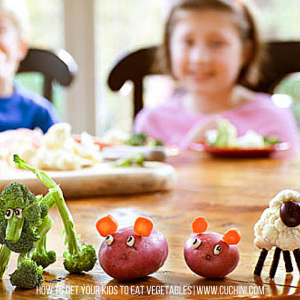 Adults can be absurdly stubborn about eating their vegetables. But when it comes to picky eating, children take the cake.
Adults can be absurdly stubborn about eating their vegetables. But when it comes to picky eating, children take the cake.
The good news is it is not impossible to have your kids eat vegetables. The bad news is that it requires consistency and persistence from the parents, and it won’t be easy. But if you’re willing to stick to your guns, you should come out triumphant in the end.
Here are some ways for you to get your kids to eat vegetables:
1. Set an example
By far the best predictor of a child’s eating behavior is the eating patterns of her parents. If vegetables and healthy foods are relegated to an afterthought in your household, it’s tough to expect your kids to take to them. Kids eat what they know, and they won’t ask for a special meal if they do not know it is an option.
2. Make food fun
Kids love to play make believe. They also love games. Broccoli can be intimidating to a kid hoping for macaroni and cheese. But if he is a dinosaur who needs to eat five miniature trees in order to outrun a tyrannosaurus rex, suddenly those florets are a lot more interesting. Relating healthy food to fun things the child already loves and turning it into a game is a great way to get a few bites of greens down the hatch.

3. Enforce the ‘one-bite rule’
Research consistently shows that children who have initially rejected a food must be exposed to it at least 8-10 times for the food to be accepted. Many parents have had success with the “one bite rule,” requiring the child to try at least one solid mouthful of a rejected food whenever it is served. After enough exposures the food will be more familiar to the child and usually they begin to rate it more favorably.
4. Don’t force them to finish
One bite is different from finishing your plate. One of the biggest misconceptions among parents is that forcing their child to eat a food she doesn’t like will get her to change her behavior. However, fighting and punishments create a negative meal experience, and the child will learn to associate food with the bad feelings. Negative food experiences have the opposite of the desired effect and actually increase picky eating tendencies. Require one bite, but try not to start a fight.
5. Reward good behavior
On the other side of the coin, creating positive food experiences can decrease picky eating tendencies. Research has shown that rewarding a child for trying one bite of a rejected food with things like stickers makes it easier for them to try the food. They are also more likely to rate the food positively in the future.
6. Offer diverse food colors
One thing you have working in your favor is that children like colorful foods. You can expose them to more colors by adding more vegetables to their plates. While adults tend to like flavors mingled together, children often prefer them separate. So you may have better luck making separate vegetable dishes instead of a big, mono-color casserole.

7. Use butter, garlic and bacon
There’s nothing wrong with adding additional flavors to vegetables to make them more appealing to children. For a picky child, the most important thing is that he gets comfortable and familiar with the rejected food. If that means serving it along with something you know he’ll enjoy, like cheese or bacon, that’s fine. I encourage you to use ingredients that are as close to real food (minimally processed without strange chemicals) as possible, but children can handle a few extra calories, especially if it helps them learn to enjoy spinach.
 Did you enjoy this article?
Did you enjoy this article?






